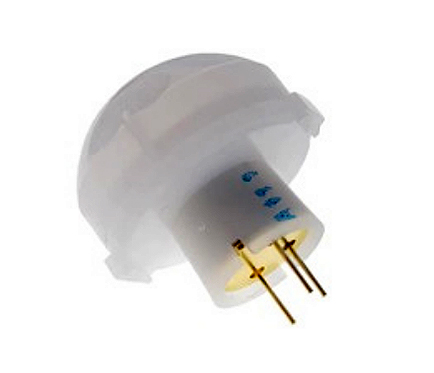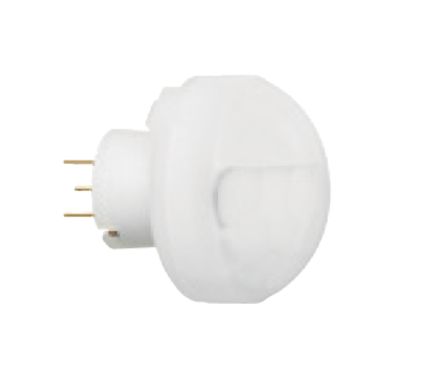People are working only to make their lives easier and more comfortable. Let’s be safe as well and it will be a perfect life to lead. To create a smart environment we first need to understand the requirements of the user.
The direction and speed of the motion also play some role in the right detection. In this article, we present information about the PIR sensor for human detection and identification.
The use of PIR sensors for human detection or motion detection is wide and it can easily sense the presence or absence. The powerful trigger also alerts the control system to send a signal either on the person’s phone or even raise an alarm.
You might have come across some of the devices bearing Panasonic PIR motion sensors like surveillance systems, security cameras, and even automatic lighting control. We will be exploring more on such use cases and applications of PIR sensors for human detection but for now, let’s dive into the information about PIR sensors and their workings.
How do PIR sensors work?
Passive infrared (PIR) sensors are very common to be used as motion detectors. The accurate readings and output of the sensor are based on some aspects like the distance between the sensor module and the object that is being detected.
The motion detection sensors working on PIR technology are not as complicated to understand as it is widely regarded. It works in a very simple and easy way in comparison to other motion-detecting sensors. Some variables impact the input of the sensor which also affects the output or reading.
It has two primary slots and each one of them is made out of very sensitive material. This material is sensitive to infrared waves also the lenses that are used are not just ordinary lenses. These are special Fresnel lenses. These come in dome-like shapes making them have a larger field of vision.
The Panasonic PIR motion sensor comes with optics and its lens is just some sort of plastic that is fixed and costs very less. Also, the type of lens used is Fresnel and it can change the range and sensing pattern along with the breadth of the sensor.
The dome-like shape of the lens helps in enlarging the field of vision, the bigger area is condensed into a smaller version and a larger detection area can be set up.
Types of PIR sensors for human detection:
As the PIR sensors have a very simple working method or technology, there are 2 common types:
The first one on this list is the thermal infrared sensor, which uses infrared for detection, and the sensitivity of the sensor is not based on the wavelength, this makes this type much slower in detection and its response to the detected object.
The second is the quantum infrared sensor; it is a highly sensitive type of PIR sensor for human detection. It uses photons for the detection and the strength of the wavelength does make an impact on the rate of detection.
This sensor is quite faster than the previous one but the only drawback is its temperature while detecting. It needs intermittent cooling time for accurate and precise detection.
What are the components of a Panasonic PIR motion sensor?
The Panasonic PIR sensors use all the essential electrical components circuit, resistor, and capacitor. The basic pyroelectric component it uses is the amalgamation of metals and crystals.
A silicone opening is provided for radiation and wavelength to pass through the metal sheet enclosing that is used for protection.
What Is the Range of the PIR sensor for human detection?
This can be classified into various categories considering the wide range of applications. We are categorizing the range of detection into 4 classes based on the detection range for the application it is used in.
Indoor application
The distance range for applications or devices that are used indoors or in smaller areas goes from 25 cm to 20 m. this range is most commonly found in home appliances and some other smaller applications.
Outdoor applications
The outdoor applications have a larger detection area and need the detection range to start from at least 10 meters to 150 meters. Such a huge detection range is needed due to the applications like security cameras and surveillance systems.
Are PIR sensors and motion detectors the same?
The Panasonic PIR motion sensor is not similar or equivalent to a motion detector. The two are quite different in their workings but sometimes people confuse each other and mix them.
The PIR sensors are used in several everyday applications to monitor activity but the motion sensors are used only in some of the very specific areas that need to determine the human presence or absence only.
The PIR sensor for human detection is very simple and small in comparison to the motion detectors. The PIRs also are very small and can easily be integrated with everyday devices and gadgets. Another benefit over any other sensor is its low power consumption. This is one of the best features that make it feasible to be used in several applications without raising the cost.
Some Advantages are:
- The PIR motion sensors deliver impeccable results, these are highly reliable and provide great accuracy.
- It can detect small and slow-moving objects even in the dark vicinity; it doesn’t require lights to detect due to its working based on infrared wavelengths.
- The PIR sensor for human detection is completely contactless and works remotely. There is no need for the object to be in physical contact with the sensor, this kind of eliminates the purpose.
- The little energy consumption is another advantage over other types of motion detectors. It helps to save cost and power at the same time.
- These work remotely and can easily be connected to a monitoring or alarm system. Automation enables independent working without human interference
Applications
There are numerous use cases and application areas for the PIR sensors, and some of them are more common than others. Here we have enlisted some:
Smart Environments
You might have seen many devices that are used to track information in commercial and residential areas. This includes devices for environmental monitoring to make sure that people are safe and living in a good environment.
These are commonly used with other varieties of sensors in applications like the smart environment for residential and commercial buildings, healthcare, and smart energy systems.
The PIR sensors are also used in quality sensing methods based on a suite of sensors, including PIR sensors, CO2 sensors, humidity sensors, and oxygen concentration sensors.
Alarm System
The security alarm is not of any use without a PIR sensor. The sensors enable the detection of humans and large warm bodies like pets, this enables to reduce the false alarms when smaller animals come into the detection area.
It detects unauthorized intrusion and raises the alarm or notifies the person through the smartphone.
Home Appliances
Modern home appliances are smarter and better than their previous generations. They are also self-sufficient and can detect issues without external help.
These home appliances are automated and work when someone is present in the room and turns off once the person steps out of the detection area.
This has changed the way home appliances used to work; you can also control them remotely through your phones or apps. It saves the cost of energy and creates a smaller carbon footprint.
Automated Doors
Automated doors are everywhere; the post-Covid-19 era needed some changes in our infrastructure to reduce the physical contact of humans with their surroundings to reduce the chances of virus transmission. Automated doors have become quite a necessity in these times. The automated doors have a PIR sensor for human detection and once the person comes near enough of the sensors; it opens the door and closes after the person is far from the sensor again.
You will find automated doors everywhere from shopping malls, standalone shops, residential and commercial buildings, and even individual houses.
Automated Lighting
The lighting sector is one of the biggest areas of Panasonic PIR motion sensors. There are smart, connected, and automated streetlights embedded with PIR sensors. It turns on and off the lights as per the requirement by sensing the presence and it has helped the governments a lot to save fuel and energy costs.
People also use these lights in homes to save costs. Staircases, hallways, entryways, exits, and bathrooms can be ideal places to install these lights.
Parking or Garage Doors
Again the parking areas use PIR sensors to enable the closing and opening of the garage without making the person get out of the car. Also, the PIRs are used to monitor the occupancy of the parking areas to open and close the parking spots for new incoming vehicles.
Occupancy system
Occupancy detection can be done effortlessly by PIRs; these can be used in shared and co-working spaces to allot the seating arrangements accordingly. Co-working and shared working spaces install on each desk to ensure the allocation and monitor the time the desks were busy.
HVAC system
HVAC systems are very common in buildings and manufacturing units to ensure the safety of people. The PIR sensors are used to ensure uninterrupted ventilation in closed and confined spaces. Lack of proper ventilation can lead to suffocation, dizziness due to lack of oxygen, and other health issues.
Conclusion
The PIR sensor for human detection has very powerful features and functions in a variety of areas with accurate and reliable output. These are quite low-cost and don’t add up to the cost of the overall device. Also, these are energy efficient too which makes them more useful in houses and offices.
The Panasonic PIR motion sensors are wired into several home appliances also like AC units and refrigerators. It uses simple infrared waves and their strength to determine movement and controls the appliances based on that.
Human detection is needed in many applications to make life more comfortable. It helps to automate some most rudimentary and basic tasks like switching the lights on and off.



